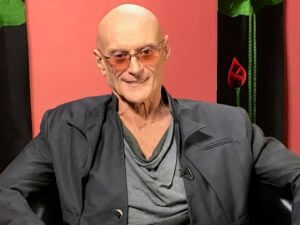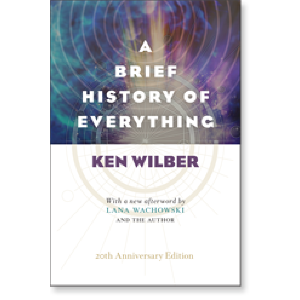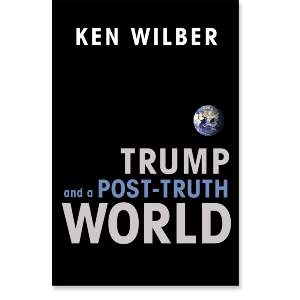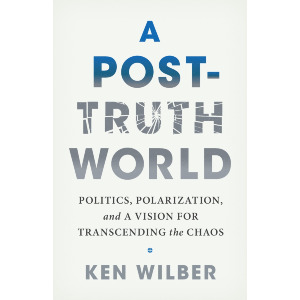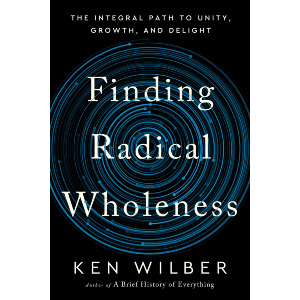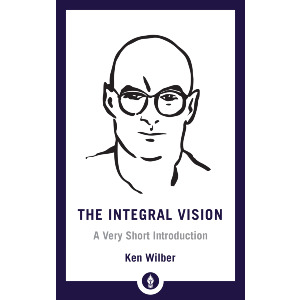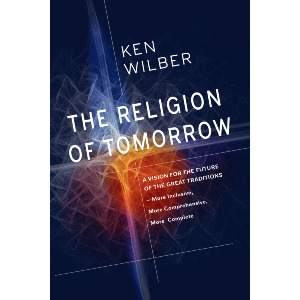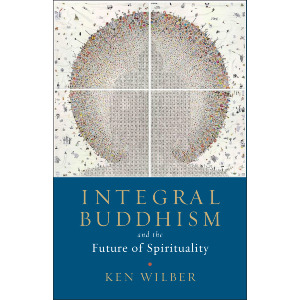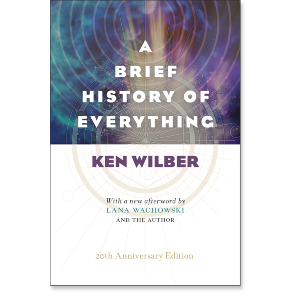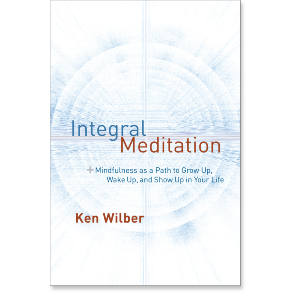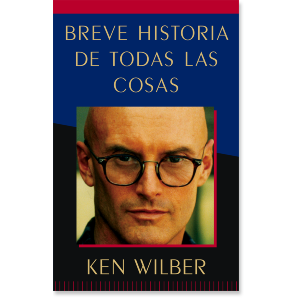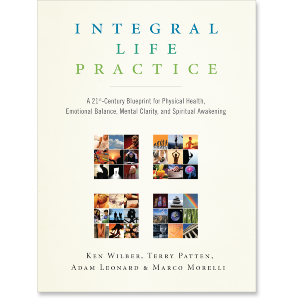KW: [Laughing] I’ve been really fortunate. I had written around a dozen books prior to SES, and in order to basically agree with my main points, you sort of had to adopt—or agree with—the central spiritual viewpoint that those books all included. And given that most forms of spirituality in the Western world are fundamentalistic, or mythic-literal or Santa Claus–like fantasies, many people were not very eager to have another spiritual view crammed down their throats. So no matter how much they might have liked much of what I was saying, they just couldn’t swallow the spiritual stuff.
But with SES, I had figured out a way that an integral view—which means ‘‘comprehensive’’ or ‘‘inclusive’’ or ‘‘holistic’’ in the best sense—can apply to all stages of development, and so you don’t have to include the spiritual stages or dimensions if you don’t want to. I think spirituality is very important if approached correctly, but with this new refinement, it’s not necessary to include a spiritual dimension in order to accept a basically integral view. Since we’re carrying this dialogue as an afterword, I can use some of the technical terms of Integral Theory to explain what I mean here, since presumably folks have finished reading the book and will know what these terms mean.
So my earlier books—like The Spectrum of Consciousness, No Boundary, The Atman Project, Up from Eden, and so on—all focused on just one quadrant (thus, No Boundary focused on the just the Upper-Left quadrant—the inside view of the individual, and Up from Eden focused on the just the Lower-Left quadrant—the inside view of the collective). But they all included the full or complete spectrum of consciousness (or all of the major levels of vertical development). Thus, they all went from, for example, prerational to rational to transrational, or subconscious to self-conscious to superconscious, or prepersonal to personal to transpersonal, or id to ego to Spirit—and so you pretty much got stuck with that full spectrum, including the upper levels (which were transpersonal and spiritual). And for many people, as I said, that spirituality part was just a little too much to swallow.
But over the years, as I was researching all of these many developmental levels (‘‘holarchies’’ or ‘‘nested hierarchies’’) that you find in virtually all human disciplines—there are developmental holarchies in everything from ‘‘stellar evolution’’ to ‘‘moral development’’ to ‘‘linguistic evolution’’ to ‘‘physiological organ systems’’ to ‘‘techno-economic modes of production’’ and on and on—I was always struck by the fact that all of these developmental holarchies looked very similar, and yet they didn’t exactly match up very well. So looking at physical evolution, you see holarchies going from quarks to atoms to molecules to cells to organisms. As with all holarchies, each of those levels is a whole that becomes part of the larger whole of the next-higher level—so a whole quark becomes part of a whole atom, a whole atom becomes part of a whole molecule, a whole molecule becomes part of a whole cell, and so on. (Each level is what Koestler called a ‘‘holon’’—a whole that is part of a larger whole. The entire universe is built of holons, and Integral Theory is a study of holons wherever they appear.)
But that holarchy didn’t match, say, the holarchy that Jean Gebser discovered in human worldviews, which he found went from archaic views to magic views to mythic views to rational to pluralistic to integral. Now that is still a holarchy—each of those levels becomes a part of the next-higher level, so each level gets more and more whole, more and more unified (just like atoms to molecules to cells). And neither of those happen to match the evolutionary holarchy of, say, the techno-economic modes of development—which run from hunting and gathering to horticultural to agrarian to industrial to informational. So everywhere I looked, I found holons organized into holarchies, and although there were many similar things about each of the holarchies, they irritatingly just didn’t match up very well. In some ways it was like they were all dealing with the same major thing, and yet in some ways they were all really different; and it just wasn’t clear what was going on here.
LW: And, as they say, this was driving you darn near nuts. I heard—and you told me this was indeed true—that you worked on this problem for almost three years, and during that three-year period, you saw exactly four people. I know where this is headed, and it’s brilliant—but it wasn’t obvious at all to begin with.
KW: Boy I’ll say. I have a reputation of being a hermit, and I’m really not; I have literally hundreds of friends and colleagues that I see often. But for those three years, I was definitely a hermit. Roger Walsh came by to check on me once each year—he’s an MD, PhD—and he’d take my pulse to make sure I was still alive, but other than him and a few accidental visitors, I saw no one. What I did was look at all these holarchies. I had one holarchy, taken from a given field—maybe physics, maybe linguistics, maybe spiritual meditation maps, maybe geopolitics—but one holarchy each written out on a large, yellow, legalpad sheet of paper—you know those yellow legal pads? I had these pieces of paper spread out all over the floor of my entire house—there were over 200 pages completely covering virtually every inch of the place. And each day I would just walk through the house, looking at all these holarchies—and then spend time reading about each one of them. So I got totally overloaded with information on these things.
LW: This is a bit of a breakthrough moment for you, very cinematic, sitting surrounded by these thoughts, these works by human beings like you, not wanting to simply exclude ideas because they were opposed, but looking for a way to transcend simpler perspectives for more complex ones.
KW: Yes, that’s right; and the first breakthrough was fairly easy, but it still was an enormous help, because it showed me that there were ways that these things fit together. The first realization was that about half of these holarchies were dealing with things that you could see with the external senses—so they were holarchies in things like physics, biology, chemistry, brain physiology, organ systems, ecological networks, economic modes, technological developments, and so on—all the things that a camera or a videotape could see (which I called the ‘‘exterior’’ view, or the view ‘‘from without’’). But then the other half were dealing with interior realities that you couldn’t see in the external world; the senses couldn’t see them, and neither could a camera or videotape—things like interior psychological realities, or awareness and consciousness, or emotions like love and hate and anger and envy, or cultural items like worldviews, or moral rules, or spiritual beliefs, and so on (the ‘‘interior’’ view, or the view ‘‘from within’’). Of course, most of the disciplines that believe in the exterior realities—that were in the first half of the holarchies—they often believe that these interior realities aren’t real realities; they are ‘‘black boxes’’ that you can’t see with the senses, and so science can’t touch them. And therefore they aren’t really real, or they don’t constitute real knowledge.
And the fact that about half of all these holarchies were dealing with these interior realities would be really weird if they were, in fact, just total fantasies or total illusions. About half of our academic disciplines would be dealing with nothing but illusions if this were true. That didn’t make any sense to me, so I decided I wouldn’t decide this issue just yet, that instead I’d just classify them all as if they were all very real and very important.
LW: So what was the second breakthrough?
KW: Right. So I divided all the holarchies into these two fundamental categories—the interior or subjective and the exterior or objective—and then I began staring at those day in and day out. And then finally—and this really was going on close to three years now, and looking back on it, as is so often the case, it just seems silly, because it all seems so utterly obvious now. (But again, that happens all the time, right? We have a really ingenious breakthrough and then everybody says, ‘‘But that’s so obvious!’’ when nobody ever saw it before.) Anyway, it finally dawned on me that each of these two types of holarchies—the interior/subjective and the exterior/objective—could be divided into individual and group, or individual and collective (or simply singular and plural). So there were holarchies that covered the interior and the exterior of an individual being, and there were holarchies that covered the interior and the exterior of groups or collectives. And when I noticed that, I went through all 200 of these things, and every one of them fit cleanly into one of those four types. And the more I looked at those four types, the more I saw that they were just four different perspectives of the same basic phenomenon, whatever that might be. So every thing and event—every holon—in the entire universe could be looked at from the inside and the outside of the individual and the collective. And with that, what I came to call ‘‘the four quadrants’’ just fell into place, and then the book started writing itself, as always happens when the theme of the book is really clear. And as simple as these four quadrants were, they answered a stunning number of really long-seated, difficult questions, from the mind/body problem to issues about spirituality, to the so-called ‘‘hard problem,’’ and on and on. It really was a revelation. And the discovery of these four quadrants went with the recognition of some other truly fundamental dimensions of human beings and of reality itself—dimensions that I called, in addition to quadrants, ‘‘levels,’’ ‘‘lines,’’ ‘‘states,’’ and ‘‘types.’’ These were the most fundamental, most basic realities that the universe—and all beings in it—were composed of, and if you wanted a truly comprehensive, inclusive, genuinely holistic view of any topic or item or issue, you needed to include all of those dimensions (‘‘all quadrants, all levels, all lines, all states, all types’’). So that became the basis of modern Integral Theory. Of course, this approach has been picked up by thousands of people around the world, and many people have made important new additions, but this was its foundational start.
—from the Afterword to A Brief History of Everything (20th Anniversary Edition), pages 313–318
